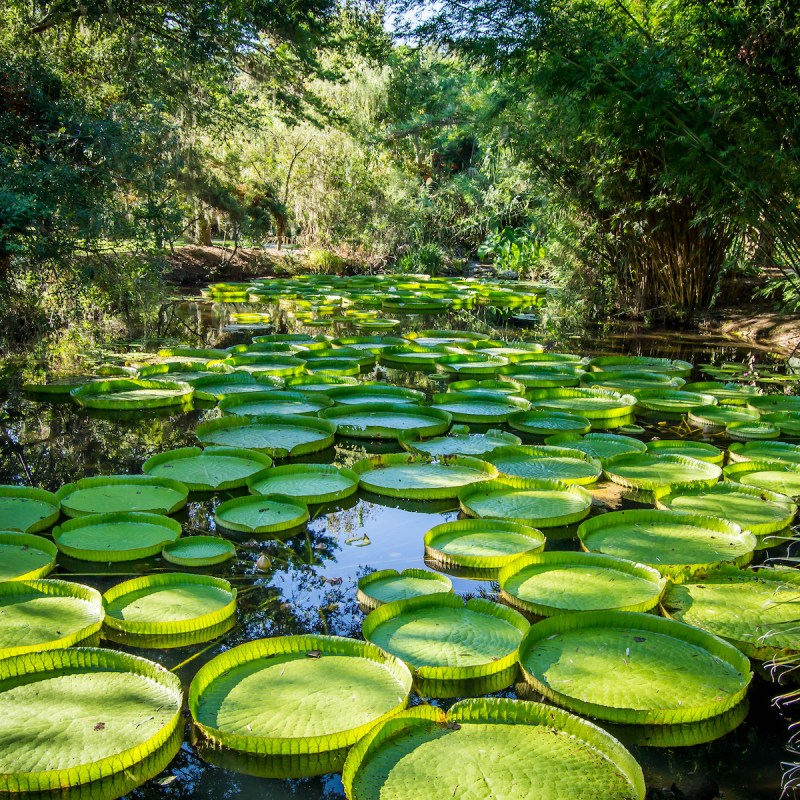
When anyone says Gainesville, Florida, people think of the college and the football team. While they are a big part of Gainesville culture, the city has an amazing number of natural attractions as well. Many are affiliated with the University of Florida, but there are others, too. From fossils to farming and bats to big cats, there is much in Gainesville for nature lovers.
Videos by TravelAwaits
I was hosted at some of these experiences, but all opinions are my own.

1. Devil’s Millhopper Geological State Park
Devil’s Millhopper Geological State Park is a National Natural Landmark. It’s a miniature rainforest at the bottom of a bowl-shaped cavity 120 feet deep. Arrowheads show people have visited the area since ancient times. One legend says when early visitors saw bones and fossils at the bottom of the sinkhole, they believed these creatures had gone there to meet the devil. In reality, the sinkhole formed when the limestone underneath it collapsed, as did most Florida sinkholes.
The pavilion, just after you enter, has placards telling the area’s story. The walk to the stairway down is short. You can view the sinkhole from the top or venture down to it. The stairs are a strenuous walk to the bottom.

2. Dudley Farm Historic State Park
Dudley Farm, an authentic 325-acre working farm on the western outskirts of Gainesville in the community of Newberry, shows the evolution of North Florida farming through the eyes of three generations of the Dudley family. It takes you from the pioneer days to the present.
Dudley Farm was the home of Ben Dudley, built in 1880. There are 17 original buildings. You can sit in a rocker on the porch, pump water from the well with a hand pump, and visit the free-range turkeys and chickens roaming the grounds. Don’t miss the Florida Cracker horses and cattle grazing in the back of the farm.
The front section contains several other historic buildings, including the visitor center, which is a museum with family artifacts showing the history of the farm. There’s a blacksmith shop and lots of antique farm equipment.

3. Florida Museum Of Natural History
This free museum is one of the nation’s top five natural history museums. In Florida Fossils: Evolution of Life and Land, you glimpse life in the last 65 million years of Earth’s history. The South Florida People & Environments exhibit walks you through Florida when it was the land of the Calusa and later the Seminole and Miccosukee people. You can play audio recordings by Native Americans. My favorite was a song by Seminole James Billie about telling a dead soul to move on.
Underwater Walk-Through lets you “be” a small fish walking through an underwater estuary where the creatures are 12 times life-sized. Discovery Zone is where kids can explore. There’s so much to see here; allow plenty of time.
Pro Tip: Butterfly Rainforest is a paid exhibit attached to the museum. It’s a living exhibit featuring around 1,000 free-flying butterflies and birds from around the world in a screened, outdoor enclosure of tropical trees and plants, waterfalls, and a walking trail. There are many other animals, including turtles and fish, too.
When you enter, the beautifully colored butterflies flutter around; some will even land on your hand or arm. You’ll see some small birds fluttering amid the bushes. You will see a variety of butterflies and probably have some favorites. One particularly beautiful species has vivid blue wings fringed with black and dots of red on its upper body, but when folded, the underside of the wings are a brown, gray, and black pattern with an eye-like marking.
4. University Of Florida Bat Barns And House
The university’s bat house and barns (across from Lake Alice) shelter about 450,000 to 500,000 bats. These badly misunderstood animals eat their body weight in bugs — including mosquitoes — every night, so everyone living in and visiting Florida should love them!
Every evening just after sunset, the bats swarm out. There is a free parking lot, and the night I was there, dozens of people were watching. The bats did not disappoint.

5. Carson Springs Wildlife Conservation Foundation
Carson Springs is home to approximately 30 rare and endangered species and over 100 animals on 275 acres of woods and farmland. They take in rescued, abused, and unwanted big cats and other animals. Each animal resident has a permanent home and lots of love here. Each animal has a name and a story. You can take a self-guided walking tour or riding tour, or arrange a private tour in advance.
This is worth seeing and such an inspiring experience. It’s fun for families and educational for children. You’ll meet mostly big cats but there are also hyenas, a rhino, river otters, jackals, lemurs, Klun Klun pigs, warthogs, foxes, and some birds.

6. Kanapaha Botanical Gardens
Kanapaha Botanical Gardens has the largest herb garden in the Southeast and is home to Florida’s largest display of bamboos. The azaleas and camellias are amazing. You can feed the fish in the ponds. The koi are fun to watch competing for the food pellets. There is a vending machine where you can buy the fish food.
The gardens offer a guided tour the first Saturday of every month at 10 a.m. It’s included with the regular admission price. The mile-and-a-half walkway is paved and offers many little side spots with waterfalls and special plant groupings. You’ll love the many sculptures and colorful children’s playground.

7. Gainesville Solar Walk
The Solar Walk is a series of sculptures created by artist Elizabeth Indianos in 2002. It stretches almost a mile and walks you through the entire solar system. There are even two sculptures for Halley’s Comet that were added in September 2008. Another artist, Tim Malles, created 10 bronze plaques that are attached to each of the planet sculptures and the sun sculpture.
Pro Tip: Park across the street in the park and meander from the sun to Pluto.
